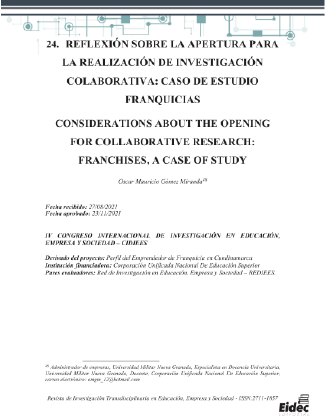XXIV. CONSIDERATIONS ABOUT THE OPENING FOR COLLABORATIVE RESEARCH: FRANCHISES, A CASE OF STUDY
##plugins.themes.bootstrap3.article.main##
Abstract
Development and investment in science, technology and innovation have a positive impact on people's quality of life and the countries economic growth. Considering the participation in the generation of knowledge is not an exclusive subject of the universities, therefore companies, the governement and society can be involved on those processes from different roles. However, in the Colombian case, the responsibility for develop research falls almost exclusively on academia, which makes it difficult to move from a theoretical approach to applicability in a real environment. From this perspective, from the development of the current study that sought to characterize the entrepreneurial profile with people that work with franchises in Cundinamarca district, we found some resistance from franchisees of being part of the survey setted up to analyze this important sector. In this sense, the environment generated the necessity to promote a collaborative research of franchises or franchises governemental institutions with universities, from a qualitative methodology which includes the reflection of the research professor. The results reflected that the franchised companies under this study have a closed approach and a low level of opening towards to collaborative work, explained by their strong standardization, the industry classified information, the rigid structure of decisions making that they depend on the owner franchisor and for fear of the possibility of revealing confidential information.
Download Statistics
##plugins.themes.bootstrap3.article.details##
University–Industry relationship, Research collaboration, Knowledge transfer in university – industry, Franchise
López, H. J. (2016). Análisis De Mecanismos De Relacionamiento Entre El Estado, La Empresa Y La Universidad En Colombia. Revista Criterio Libre, 14(25), 172-201. Lyu, L., Wu, W., Hu, H., & Huang, R. (2017). An evolving regional innovation network: collaboration among industry, university, and research institution in China’s first technology hub. The Journal of Technology Transfer, 1-22. Doi: 10.1007/s10961-017-9620- x Martínez Navarro, M., y Jaya Escobar, A. I. (2019). La gestión de la ciencia, la tecnología y la innovación en la educación superior: trayectorias y desafíos. Atlante Cuadernos de Educación y Desarrollo, (febrero 2019). En línea: https://bit.ly/3sOsOOR Ministerio de Ciencias, Tecnología e Innovación. (2021). Presupuesto Ministerio de Ciencias, Tecnología e Innovación 2010-2021. Disponible en: https://bit.ly/38bHMF8 Mohr, J. J., Fisher, R. J., y Nevin, J. R. (1996). Collaborative communication in interfirm relationships: moderating effects of integration and control. Journal of marketing, 60(3), 103-115 Morales, M. E., Ortíz, R. C., y Arias, C. M. A. (2012). Factores determinantes de los procesos de innovación: una mirada a la situación en Latinoamérica. Revista EAN, (72), 148- 163. Morales, M.; Sanabria, P., y Caballero, D. (2015). Características de la vinculación Universidad-Entorno en la Universidad Nacional de Colombia. Revista Facultad de Ciencias Económicas: Investigación y Reflexión, XXIII, 189-208. Morales, M. E., Rangel, P. E. S., y Pacheco, P. A. P. (2016). Factores determinantes y tendencias de la transferencia de resultados de investigación universitaria al sector productivo. Criterio libre, 14(25), 135-170. Moon, H., Ham, S., Kim, S. C., y Lee, B. Y. (2021). Influential factors for successful knowledge transfer in restaurant franchises. Journal of Hospitality and Tourism Management, 46, 224-232. OCDE. (2021). Government at a Glance 2021, OECD Publishing, Paris, Doi.org/10.1787/1c258f55-en. OCyT. (2020). Indicadores de ciencia y tecnología 2019. Bogotá: Observatorio Colombiano de Ciencia y Tecnología. Disponible en: https://bit.ly/3mF1y4i
Paredes-Frigolett, H. (2016). Modeling the effect of responsible research and innovation in quadruple helix innovation systems. Technological Forecasting and Social Change, 110, 126-133. Park, S. C. (2018). The Fourth Industrial Revolution and implications for innovative cluster policies. AI & SOCIETY, 33(3), 433-445 Phillips, F., y Alarakhia, S. (2014). The triple helix: International cases and critical summary. In Technopolis (pp. 67-90). Springer, London. RICYT. (2020). Red de Indicadores de Ciencia y Tecnología Interamericana e Iberoamericana. Disponible en: https://bit.ly/3mu1xjO Salgado, A. (2007). Investigación cualitativa: diseños, evaluación del rigor metodológico y retos. Liberabit. Revista de Psicología, 3, 71-78. Shujahat, M., Sousa, M. J., Hussain, S., Nawaz, F., Wang, M., y Umer, M. (2019). Translating the impact of knowledge management processes into knowledge-based innovation: The neglected and mediating role of knowledge-worker productivity. Journal of Business Research, 94, 442-450. Sierra, J. (2018). La cuarta hélice y la financiación de la innovación. Journal of Economics, Finance and Administrative Science, 23(45), 125-137. Torres, F. O., Fernández, V. G. L., Espinoza, M. D. R. M., y Cabrera, R. O. (2019). El Modelo Tetra Hélice para el desarrollo de innovación tecnológica. EDUCATECONCIENCIA, 21(22), 75-92. Vega-Jurado, J. M., Fernández-de-Lucio, I., y Huanca-López, R. (2007). La relación universidad-empresa en América Latina: ¿apropiación incorrecta de modelos foráneos?. Journal of Technology Management & Innovation, 2(3), 97-107. Watson, A., Senyard, J., y Dada, O. L. (2020). Acts of hidden franchisee innovation and innovation adoption within franchise systems. Industrial Marketing Management, 89, 431-445. Yakimova, R., Owens, M., y Freeman, S. (2021). The ‘visible hand’behind cooperation in franchising: A model of franchisor practices that influence cooperation within social networks. Industrial Marketing Management, 94, 66-89. Yerovi, A. B. P. (2017). La comunicación interna-externa como estrategia motivacional de las organizaciones. Didasc@ lia: didáctica y educación, 8(3), 179-186.
Yu, X., Jingdong, Y., Fan, Z., Mushtaq, H., y Quan, Z. (2020). Sustainable development of sci-tech service intermediaries based on triple helix model of innovation. International Journal of Sustainable Development and Planning [Internet], 15(4), 513-519


 https://orcid.org/0000-0001-6658-3403
https://orcid.org/0000-0001-6658-3403



